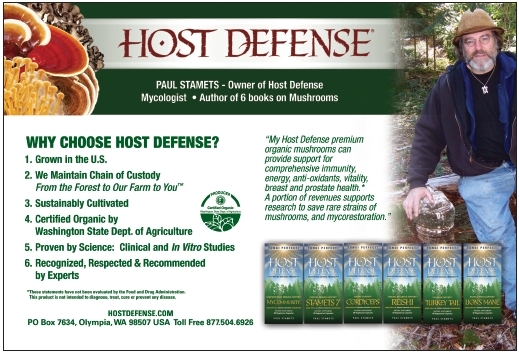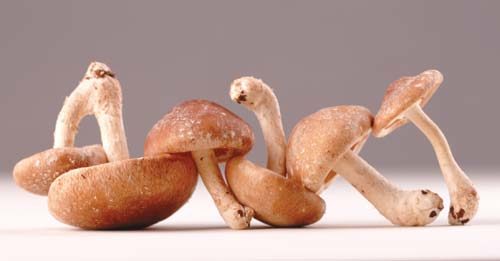Mushrooms are sold in every produce department, but are they in your supplement aisles? Medicinal mushrooms should be right there as options for keeping your customers strong and healthy. The mushrooms most Asian cultures have been using for thousands of years are currently growing in popularity in the United States with advances in medical research. With immune systems enhancers, heart health supporters and diabetic aids, mushrooms can offer your customers much more than just being another topping on a slice of pizza.
Properties of the Medicinal Mushroom
Mushrooms from a dietary standpoint contain a multitude of essential compounds. They offer vitamins like thiamine (B1), riboflavin (B2), biotin, ascorbic acid, niacin and in some cases, vitamins A and D. Carbohydrates are present at around 3–21% depending on dry weight, but so is fiber at 3–35% of the weight, which makes up a majority of the carbohydrates (1). Mushrooms also contain digestible proteins at 10–40% of dry weight, essential amino acids, phosphorous, potassium, some calcium and iron and low levels of crude fat lipid compounds (1).
For health, polysaccharides play the largest role and have been the most studied element of mushrooms used in medicine. Polysaccharides are polymers of monosaccharide residues joined to each other by glycosidic linkages and can carry biological information that allow for various cell interactions and communications (1). Potentially, these polysaccharides can promote change within the body. In mushrooms, the most interesting and studied polysaccharides are of the antitumor and immunostimulative varieties, often used in cancer research (though this is not yet proven as a treatment). Studies have found that these specific polysaccharides, also known as beta-glucans, are present in high levels in mushrooms (1).
The First Step: Extraction Methods
Receiving the benefits of medicinal mushrooms is not necessarily as easy as adding sliced button mushrooms to a salad. The polysaccharides must be extracted from the outer layer of the mushroom to ensure potency. The most widely used technique throughout the world is hot-water extraction, which comes from ancient Chinese traditional and folk medicines (2). Heat is needed to break down the mushroom’s tough cell walls or chitin to extract the polysaccharides. The result is dehydrated and powdered to be sold in packaged or pill form (2).
This is not the only accepted extraction technique; in the United States, another widely used technique is tincture, or alcohol extraction (2). The mushrooms are heated in an 80% ethanol solution then precipitated, leaving a purified extraction behind (1). Both are viable methods, though some claim the hot-water method preserves the integrity of the mushrooms better than ethanol (2); however, others believe that from a manufacturing point of view, ethanol extraction is more cost effective and less time consuming (1).
Still others choose not to use an extraction method at all, powdering and eating the raw fruit bodies (the flowering, edible part of mushrooms most often found in produce sections) as a way to not meddle with the mushroom’s properties at all.
However digested, medicinal mushrooms are being used with potentially positive results for a multitude of health benefits, and are gaining popularity among research circles in the western world. Despite there being at least 270 species of mushrooms with medicinal potential (1), let’s focus on some of the more common mushrooms being used in research today.
Five to Look For
Shiitake mushrooms are well-known for their delicious addition to hot dishes, but besides being a dietary staple in Asian cultures, shiitake may also have tumor reduction mechanisms. These dark brown, umbrella-shaped fungi are native to East Asia, but have been grown in the United States for at least 20 years. Shiitake contain essential amino acids, vitamins, minerals and polysaccharides, specifically lentinan, which was approved as an anti-cancer agent in Japan in the 1980s (3). Lentinan as the active compound of shitake may aid in reducing high cholesterol, lowering blood pressure and healing infections, along with the affects it has on tumor reduction. In studies, patients with stomach cancer were intravenously given lentinan while women with breast cancer were injected following surgery, and in both situations, immune-directed disruption of the tumors took place (3). Lentinan may increase the activity of cells involved in killing cancerous cells.
In another study, lentinan was administered along with vitamin C and other supplements to 55 patients ranging in age from 28 to 65, who had been previously exposed to toxic chemicals such as formaldehyde, pesticides and solvents. This exposure resulted in fatigue, memory loss, skin rashes, coughing, shortness of breath and abnormalities in the nervous, respiratory and immune systems. T-cell activity was tested and 24 hours after the cocktail was administered orally, the average activity of the T-cells went up by 78%, although more research is needed to determine the effects of lentinan within this study (4).
The most commonly found mushroom in the United States is the white button mushroom; they make up 90% of the States’ total mushroom production and are part of the agaricus bisporus family, along with portabella and crimini. White button contain B vitamins, vitamin D, zinc, selenium, potassium and copper, and are a possible immune enhancer. They are being used for supporting the immune system, lowering of blood sugar and reducing insulin resistance in diabetics and hepatitis research (3).
One study of blood glucose levels used white button mushrooms to test its effects on heart and typically diabetic diseases. One group of rats was fed a hypercholesterolemic diet (0.5% cholesterol and 14% fat) while a group of rats with type-2 diabetes were injected with streptozotocin, a natural chemical toxic to insulin-producing beta cells in the pancreas, and fed agaricus bisporus powder for three weeks. These rats were found to have significantly reduced plasma glucose and triglyceride concentrations, liver enzyme activities and liver weight gain. Four weeks of feeding the rats the mushroom powder resulted in decreases in plasma total cholesterol and low-density lipoprotein. The study concluded that the white button mushroom had both hypoglycemic and hypolipidemic activity in rats (5).
White button may also help women with breast cancer going through menopause as agaricus mushrooms have been shown to possess anti-estrogenic actions, which will cause post-menopausal women to produce less estrogen and reduce the risk of continued or new growth of breast and ovarian cancer tumors (3).
Known as the “king of the mushrooms” in Japan, maitake (Grifola frondosa) is the only edible mushroom in the Monkey’s bench family of mushrooms, which are known as immune enhancers (6). These beasts reach up to 20 inches high and a cluster could weigh up to 100 pounds. Maitake contain B vitamins, vitamin D, protein and ergosterols. The most active and strongest compound in maitake is the protein-bound, beta-glucan proteoglucan, also called “d-fraction,” a strong immune system enhancer (6). Beta-glucan is known for its immune-activating and anti-tumor properties, but tends to lose potency if taken orally. In maitake, however, the unique proteoglucan beta-glucan compound does have the same effect whether taken orally or injected (6), which could provide for easier distribution and accessibility; in fact, maitake supplements have been in the United States market since at least 1995.
Along with immune enhancing, maitake has shown to help with hypertension in diabetics as it helps lower blood sugar and pressure, as well as risk of heart and blood vessel diseases. In one study on the effects of powdered maitake on rats, 30 mg per kg of maitake was given to rats that suffered from hypertension. Blood pressure was lowered by the end of the testing, according to the study (7). Before taking maitake, advise that customers taking prescription medication for diabetes should first consult their doctor before taking a new supplement or changing their diet (6).
A mushroom gaining popularity in the United States is the hericium erinaceus or “Lion’s Mane” mushroom, called so for its cascading white tendrils. It has been used as an immune system, a blood sugar and a dementia aid because of its ability to inhibit toxic peptides in brain cells and stimulate nerve growth in the brain as well. Lion’s Mane contains protein and zinc, and its active compounds include amyloban and hericenones. The hericenones are what help stimulate nerve growth, and are actively being used in research for Alzheimer’s disease. In addition, hericenones limit cell death associated with the disease and amyloban reduces the toxicity of beta-amyloid plaques; together, they help reduce symptoms of the disease. Although there is at least one branded supplement in Japan using the amyloban hericenones combination to combat Alzheimer’s and small human trials showing promise, patent is pending in the United States (3).
One mushroom currently being researched and applied in at least one major cancer research center is the reishi or “mushroom of immortality” as called in ancient Eastern medicine. Reishi has the longest reported historical use of medicinal mushrooms, having been used in China for over 4,000 years (3). They can be found growing on logs, trees and plants, and are red and kidney-shaped, soft, flat and cork-like in texture.
Reishi contain polysaccharides (beta-D-glucan), sterols or steroid alcohols (ergosterol), fungal lysozyme, proteinase, triterpenes (ganoderic acids), lipids, alkaloids, glucosides, volatile oil, riboflavin, ascorbic acid and amino acids. These elements are used to aid with fatigue, high cholesterol, HIV and AIDS, hypertension, immunostimulation, inflammation, strength and stamina and viral infections. Its high immunostimulation properties are what make this mushroom a viable element in cancer research. In studies, reishi has been shown to kill leukocytes (white blood cells) and enhance immune response in advance-stage cancer patients by increasing plasma antioxidant capacity. Reishi also helps during chemotherapy by reducing nausea, enhancing the effect of radiotherapy and increasing the sensitivity of cancerous ovarian cells to certain chemotherapy drugs (8).
In one case study performed onadvanced-stage cancer patients, a branded reishi supplement was given to 34 patients suffering from different cancers three times a day for 12 weeks. The goal of the study was to see if there were changes in the immune functions of the patients, specifically monitoring cytokines, T-cells subsets and natural “killer activity.” The result showed a positive increase in T-cell populations after the 12-week period, but more studies are needed to confirm this effect (8).
Reishi should not be taken with the following: anticoagulants or antiplatelets as the mushroom may increase risk of bleeding; immunosuppressants as reishi is meant to increase immune responses; chemotherapeutic agents as reishi may increase plasma antioxidant capacity and negatively interact with agents relying on free radicals; cytochrome P450 substrates as reishi inhibits CYP2E1, CYP1A2 and CYP3A and may negatively interact with the drugs metabolized by those enzymes (8). Although there are strides being made, more research is needed to determine reishi’s affect on cancer and other diseases.
When choosing mushrooms in the produce aisles, avoid pesticides and slimy ones not firm to the touch. Ingesting large quantities may induce bloating or diarrhea, especially if using mushrooms for the first time. Customers who have gout or kidney stones should avoid ingesting more than 15 grams a day. WF
References
1. R. Sullivan, “Medicinal Mushrooms: Their Therapeutic Properties And Current Medical Usage With Special Emphasis On Cancer Treatments,” http://kcl.academia.edu/RichardSullivan/Books/259287/Medicinal_Mushrooms_Their_therapeutic_properties_and_current_medical_usage_with_special_emphasis_on_cancer_treatments, accessed Mar. 1, 2012.
2. “A Brief Overview of Mushroom Extracts,” www.promedics.ca/pdf/medicinal_mushrooms_overview.pdf, accessed Mar. 1, 2012.
3. L. Alschuler and K. Gazella, Mushrooms (Active Interest Media, El Segundo, CA, 2009).
4. G. Heuser and A. Vojdani, “Enhancement of Natural Killer Cell Activity and T and B Cell Function by Buffered Vitamin C in Patients Exposed to Toxic Chemicals: The Role of Protein Kinase - C,” www.vitasearch.com/get-clp-summary/18918, accessed Mar. 1, 2012.
5. S.C. Jeong et al., “White Button Mushroom (Agaricus Bisporus) Lowers Blood Glucose and Cholesterol Levels in Diabetic And Hypercholesterolemic Rats,” Nutr. Res. 30(1), 49–56 (2010).
6. M. Kaylor and K. Babel, Syndrome X and SX-Fraction (Woodland Publishing, Orem, UT, 2003).
7. A. Kyoko, et al., “Blood Pressure-Lowering Activity Present in the Fruit Body of Grifola Frondosa (Maitake),” Chemical Pharmacol. Bull. 36 (3), 1000–1006 (1988).
8. Memorial Sloan-Kettering Cancer Center, “Reishi Mushroom,” www.mskcc.org/cancer-care/herb/reishi-mushroom, accessed Mar. 1, 2012.
Published in WholeFoods Magazine, June 2012









